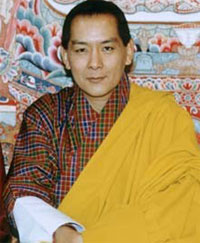I start with the back side of the note:
Similar to the 100 ngultrum note, the picture on the back side of the 1000 ngultrum note, is the dzong of Tashichho.
The picture is similar to, but not exactly the same as the 100-note.
 |
| 1000 ngultrum - back side |
 |
| Tashichho Dzong in Thimphu, Buthan |
By flipping the banknote, the colour shifts from reddish to greenish gold.
 |
| colour shifting seal - 1000 ngultrum |
 |
| full colour seal of Bhutan |
 |
| golden seal - 1000 ngultrum |
At the front we see another seal. This is in gold print and has not colour shift.
The seal of Bhutan is composed of a double diamond-thunderbolt (dorje) placed above a lotus, surmounted by a jewel and framed by two dragons.
The thunderbolt represents the harmony between secular and religious power.
The lotus symbolizes purity; the jewel expresses sovereign power; and the two dragons, male and female, stand for the name of the country which they proclaim with their great voice, the thunder.
 |
| 1000 ngultrum - front side |
 |
| detail King Jigme K. N. Wangchuck |
It is the so called "Raven Crown".
In the previous article (about the 500 ngultrum note) you can see a picture of the first king of Bhutan, wearing a similar type of crown.
 |
| Raven Crown - Bhutan |
 |
| Raven Crown - Bhutan 500 ngultrum note |
The Raven Crown today is the official crown worn by the Kings of Bhutan. The Raven is the national bird of Bhutan. The raven is known locally as Jaroq. At one time it was a capital crime to kill a raven in Bhutan.
The hereditary monarchy of the Wangchuk dynasty in the independent Himalayan State of Bhutan was established in 1907. The first king of the Wangchuk dynasty, Sir Ugyen Wangchuck (1862–1926), was a charismatic figure who came to power against a turbulent background of incessant and complex feuding in that chaotic warrior state. He adopted as the unique symbol of his authority a crown surmounted by the head of a raven.
The bird represents a form of "Mahakala", Bhutan's guardian deity. The prototype of the founding monarch's Raven Crown had first been devised as a battle helmet for his father, Jigme Namgyel (1825–81). Known as the Black Regent, he had worn it in bloody struggles against his many rivals within the country and against the British who tried, unsuccessfully, to subdue him.
Hereditary Kings of Bhutan
- His Majesty Ugyen Wangchuck (1st Druk Gyalpo)
- His Majesty Jigme Wangchuck (2nd Druk Gyalpo)
- His Majesty Jigme Dorji Wangchuck (3rd Druk Gyalpo)
- His Majesty Jigme Singye Wangchuck (4th Druk Gyalpo)
- His Majesty Jigme Khesar Namgyel Wangchuck (5th Druk Gyalpo)

























